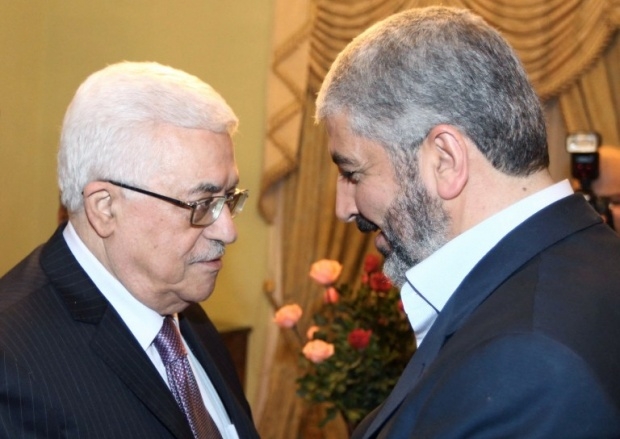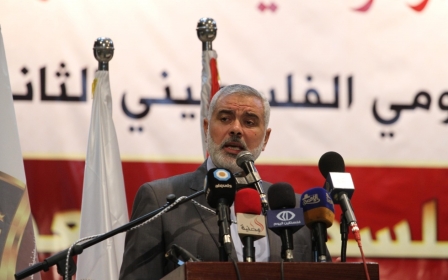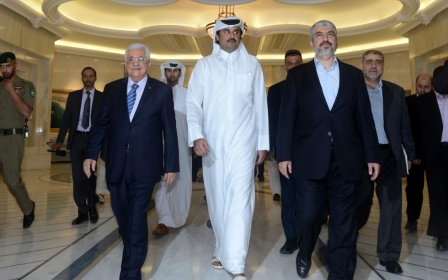Hamas seeks to further its strategic priorities in Gaza

Since the end of Israel's last military campaign in Gaza, Hamas has focused on the accomplishment of stated goals in the battlefield as the major criterion in assessing each side’s performance, holding that Gaza’s armed groups emerged with the upper hand.
The deployment of victory rhetoric comes partly in anticipation of a political setback if planned Egyptian-mediated talks to reach a long-term settlement fail to yield substantive political gains.
Hamas also aims to highlight that the movement’s strategic priorities in managing the broader conflict with Israel extend beyond achieving immediate benefits for the beleaguered Gaza Strip.
Hamas’s political-military approach during operation Protective Edge aimed at advancing parallel long-term objectives integral to its vision for a comprehensive national strategy to counter Israel’s practices and policies, according to its leaders statements.
Its first objective was coordinating a unified non-partisan response to Israel’s latest attack on the territory, thus restoring Hamas to the national fold and placing the Gaza crisis back on the agenda of the Palestinian Authority (PA).
The PA and Palestinian Liberation Organization (PLO) officially endorsed Hamas’s truce demands within hours of a meeting between Palestinian President Mahmoud Abbas and Hamas chairman Khaled Meshaal in Qatar on 21 July following efforts by Turkey and other regional leaders.
The meeting appeared to have fulfilled Hamas’s goal. The PA began to openly reject calls to disarm Gaza. Perhaps for the first time, Abbas was commissioned to speak on behalf of Hamas.
A PA position, once in favour of the Israeli blockade to choke its opponent, pointed to Israeli intransigence as the cause behind the failure to reach an agreement, as Palestinian factions coalesced to drive a joint agenda.
“There is a Palestinian delegation and its head is affiliated with the Palestinian Authority in Ramallah. It speaks for all the factions, presenting their unified demands”, senior Hamas leader Ahmad Yousef said before the truce began.
Behind closed doors however, fundamental disagreements emerged over various issues, including repeated ceasefire extensions, Hamas’s rejection of the Egyptian initiative, and each side excluding the other from important decisions, according to leaked transcripts of high-level meetings.
Differences revealed in an exchange of public barbs after the truce came into effect indicated that projecting a unified front was a tactical maneuver serving internal dynamics on both sides.
Abbas has accused Hamas of running a shadow government in Gaza and is now insisting that the movement disarm, and Fatah’s Central committee issued a charged statement denouncing its rival. Hamas leaders, intent on deescalating a budding crisis, called for a meeting to resolve outstanding issues that threaten to derail the short-lived partnership,
“Abbas and Hamas have dramatically different views” Fawaz Gerges, an expert on mainstream Islamic movements noted “But Hamas, like any social and political movement wants to survive, and the PA had to readjust its discourse as a result of a shift in public opinion.”
By conceding to the Ramallah based leadership, Hamas sought to secure its role as a partner within the national unity authority, “not just in theory but also within an institutional framework as part of a renegotiated political process”, Gerges added.
Furthermore Israeli Prime Minister Benjamin Netanyahu was determined to deny Hamas a political victory. A PA role was essential to facilitating a lasting agreement and preserving Hamas’ clout in Gaza.
Conversely, Israel considered reestablishing Fatah as a dominant factor in Gaza’s political scene as a way to undermine Hamas.
Earlier in the negotiations Justice minister Tzipi livni proposed restoring the PA and placing disputed portfolios, like the seaport and airport, in the hands of the Abbas led PLO, according to the New York Times, as part of a final status agreement that has yet to be negotiated.
But a significant spike in Hamas’s popularity following the offensive along with rising cross-factional demands to restructure the PA and the PLO have helped Hamas’s realize a second objective of the conflict: setting a new launching point for the internal Palestinian political process.
In a meeting between Hamas and the PA in Qatar, Meshaal warned Abbas against monopolizing political decisions, as it started to become clear that the Fatah led consensus government would likely handle the reconstruction dossier.
Furthermore, Hamas has recently requested that Abbas review the formation of the PA cabinet.
Abbas is reportedly open to a cabinet reshuffle that would include more ministers, as well as a deputy Prime Minister from Gaza, but it is unclear whether Hamas members or loyalists will be considered for the new posts.
Hamas has signaled its readiness to integrate into the broader political system, as part of its efforts to achieve a third long-term objective of gaining recognition as a legitimate political actor while maintaining its essential ideological underpinnings.
Most influential countries have already relaxed their positions towards Hamas, ratifying a Palestinian consensus government that recognizes the principles of the Middle East Quartet without requiring its individual components (including Hamas and other members who do not recognize Israel) to do so.
In principle Hamas rejects the Quartet's conditions, but has tacitly agreed to honour its terms, while operating under the current government, including negotiating within the framework of past agreements with Israel.
“Our hope is to achieve a resolution that fulfills the Palestinian delegations demands which are all legitimate and consistent with Oslo”, Yousef stated when asked about an optimal final status arrangement related to recent negotiations.
Hamas also stands firm on its refusal to recognize Israel, but has repeatedly stated its willingness to accept a state within the 1967 borders.
In an interview aired two weeks into Israel’s offensive Meshaal demonstrated even further adaptability, saying that the decision of whether or not to recognize Israel lies with a future Palestinian State, and not a single political organization.
The biggest obstacle to international recognition however remains Hamas’s commitment to expanding its military branch.
Hamas has ruled out Israel’s condition to disarm in return for concessions on key Palestinian demands, including ports and the release of prisoners.
Israeli negotiators had replaced an internationally backed but unfeasible demand of demilitarizing Gaza with a call to end weapons smuggling in order to reach an initial truce agreement.
Israel did not properly assess Hamas’s capabilities, expertise, and dimensions, a prominent Israeli columnist noted, as over the years Hamas’s brigades morphed from compartmentalized cells to a real army.
To dismantle Hamas’s military capabilities, it will be necessary to dismantle Hamas first, he added.
But in the same way that a long-term truce constitutes a strategic option rather than an endstate for Hamas, estimations of the utility of combat are subject to political developments and tactical considerations.
And while armed struggle is at the core of Hamas’s liberation philosophy, as early as 2006 Meshaal affirmed that Hamas is ready to halt fighting if Israel committed itself to ending the occupation.
More recently, the movement steadfastly observed a 19-month ceasefire, before the latest violence broke out.
Palestinians have yet to reach a consensus on proposals to determine the official capacity of groups operating outside government control, but in this respect, Hamas has managed to achieve a fourth objective fundamental in its pursuit of political integration ahead of Palestinian national elections slated for 2015.
The group has furthered its efforts to establish a clear division of its designated branches, casting its military wing, the Al-Qassam Brigades, as an arm of the organization, but treating it as a separate entity.
More than ever before, the political wing and the military apparatus appeared to be leading separately during the latest Israeli attacks. “We do not consider any political developments to be binding”, Al-Qassam’s spokesperson Abu Obaida announced following an assassination attempt on the groups chief commander.
In another televised statement ahead of a 72 hour truce Abu Obaida proclaimed: “We the Ezz el Din el Qassam Brigades…will give the political leadership of our faction the opportunity to negotiate”, pointing to the independence of the movements military command structure.
Yousef ascertained that Hamas’s military apparatus is subordinate to its political wing. “The political bureau employs a consultative approach and its decisions are informed by developments on the battlefield, but it has the final say”, he stated.
But the movement's deputy chairman, Mousa Abu Marzouk told reporters that Hamas will keep its military wing distinct, adding that it will remain outside the new government’s control.
The Fatah-led PA has recently resumed limited crackdowns on Hamas-affiliated combatants in the West Bank, but is powerless to prevent the capabilities of armed groups, and support for the armed approach from growing
“It’s an empirical fact that Hamas has become more popular”, Gerges affirmed. “Even though Israel was able to exact damage on Hamas, politically and sociologically Hamas has gained.”
In the absence of internal coherence, each party is playing to its own strengths, approaching the Palestinian-Israeli conflict with competing and often clashing strategies.
Though hopes are dim that further truce talks will yield sustainable solutions to Gaza’s accumulating crises, Hamas has managed to make inroads towards resetting the terms of a decades old power configuration, opening the door for the movement to perhaps one day formally assume power.
New MEE newsletter: Jerusalem Dispatch
Sign up to get the latest insights and analysis on Israel-Palestine, alongside Turkey Unpacked and other MEE newsletters
Middle East Eye delivers independent and unrivalled coverage and analysis of the Middle East, North Africa and beyond. To learn more about republishing this content and the associated fees, please fill out this form. More about MEE can be found here.



